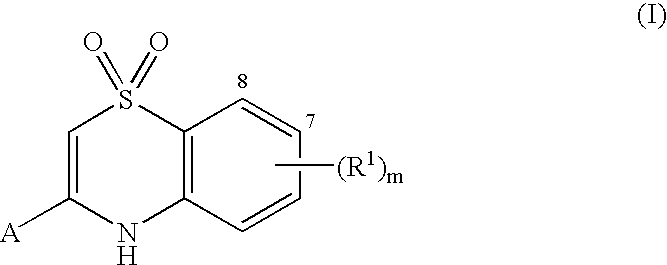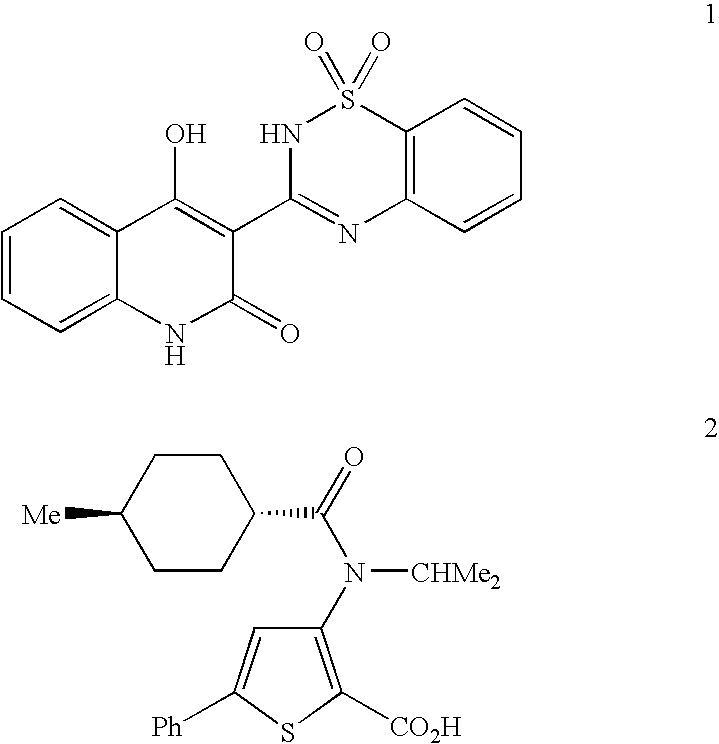Heterocyclic antiviral compounds
- Summary
- Abstract
- Description
- Claims
- Application Information
AI Technical Summary
Benefits of technology
Problems solved by technology
Method used
Image
Examples
example 1
3-(1,1-Dioxo-1,4-dihydro-1λ6-benzo[1,4]thiazin-3-yl)-4-hydroxy-1-(3-methyl-butyl)-1H-quinolin-2-one (I-1, SCHEME 1)
[0265] step 1—To a solution of 2-aminothiophenol (4.96 g, 39.6 mmol) in MeOH (200 mL) was added the ethyl 4-chloroacetoacetate (6.2 g, 38 mmol). After stirring at room temperature for 2 h the MeOH was removed under reduced pressure. The residue was dissolved in Et2O and washed with HCl (1N), saturated NaHCO3, and brine. The organic phase was dried over MgSO4, filtered and the solvent was removed under reduced pressure. The product was obtained from a minimum of EtOH to afford 5.0 g (54%) of 8: LCMS RT 3.7 min, M+H.
[0266] step 2—To a solution of 8 (1.0 g, 4.3 mmol) in THF (50 mL) was added the di-tert-butyl dicarbonate (1.86 g, 8.5 mmol) and DMAP (1.0 g, 8.5 mmol). After stirring at rt for 1 h, the solvent was removed under reduced pressure. The residue was dissolved in DCM and washed with 1N HCl. The organic phase was concentrated and the product was purified by colum...
example 2
3-(1,1-Dioxo-1,4-dihydro-1λ6-benzo[1,4]thiazin-3-yl)-6-fluoro-1-(4-fluoro-benzyl)-4-hydroxy-1H-quinolin-2-one (I-13)
[0283] To a solution of thiazine acetic acid ester 4 (0.20 g, 0.69 mmol) in THF was added NaH (0.11 g, 60% in oil, 2.8 mmol). After 10 min, 1-(4-fluorobenzyl)-6-fluoro-isatoic anhydride (22) was added. The reaction mixture was heated at reflux for 30 min and then the mixture was cooled to rt. HOAc (1 mL) was added and the mixture was heated again at reflux for 30 min. The solvent was removed under reduced pressure and 1N HCl (10 mL) was added to the residue. The mixture was extracted with Et2O. The combined organic phase was washed with brine and dried (MgSO4), filtered and the solvent was removed under reduced pressure. The residue was dissolved in DCM and then concentrated under reduced pressure. This process was repeated. The resulting solid was dried under vacuum. The product was triturated with Et2O, which required sonication, and the resulting precipitate collec...
example 3
3-(6-Fluoro-4-hydroxy-1-isobutyl-2-oxo-1,2-dihydro-quinolin-3-yl)-1,1-dioxo-1,4-dihydro-1λ6-benzo[1,4]thiazine-6-carbonitrile (I-16)
[0287] A tube was charged with I-7 (0.400 g, 0.9 mmol), Zn(CN)2 (63 mg, 0.54 mmol), DPPF (100 mg, 0.18 mmol), zinc dust (35 mg, 0.54 mmol, and Pd2(dba)3 (82 mg, 0.89 mmol). The tube was purged with N2, sealed and heated to 120° C. for 3.5 h. After cooling, the mixture was poured into 10% aqueous NH4OH. The solution was washed with ether. The product was extracted into EtOAc. The organic phase was washed with brine and dried over MgSO4. The product was purified by column chromatography on SiO2 eluting with EtOAc / MeOH to afford 0.115 g (29%) of I-16: LCMS RT 2.65 min, M−H.
PUM
| Property | Measurement | Unit |
|---|---|---|
| Volume | aaaaa | aaaaa |
| Volume | aaaaa | aaaaa |
| Mass | aaaaa | aaaaa |
Abstract
Description
Claims
Application Information
 Login to View More
Login to View More - R&D
- Intellectual Property
- Life Sciences
- Materials
- Tech Scout
- Unparalleled Data Quality
- Higher Quality Content
- 60% Fewer Hallucinations
Browse by: Latest US Patents, China's latest patents, Technical Efficacy Thesaurus, Application Domain, Technology Topic, Popular Technical Reports.
© 2025 PatSnap. All rights reserved.Legal|Privacy policy|Modern Slavery Act Transparency Statement|Sitemap|About US| Contact US: help@patsnap.com



